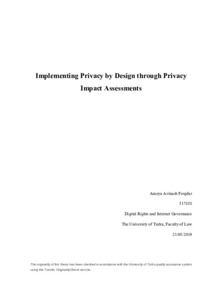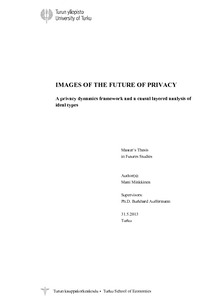Implementing Privacy by Design through Privacy Impact Assessments
Foujdar, Ameya (2019-05-22)
Implementing Privacy by Design through Privacy Impact Assessments
Foujdar, Ameya
(22.05.2019)
Julkaisu on tekijänoikeussäännösten alainen. Teosta voi lukea ja tulostaa henkilökohtaista käyttöä varten. Käyttö kaupallisiin tarkoituksiin on kielletty.
avoin
Julkaisun pysyvä osoite on:
https://urn.fi/URN:NBN:fi-fe2019061019771
https://urn.fi/URN:NBN:fi-fe2019061019771
Tiivistelmä
Privacy has come a long way from being a fundamental physical right to being implemented as virtual online privacy under GDPR. Recent privacy breaches around the world have highlighted the role of the design of information systems in protecting the privacy of individuals online. GDPR envisions to achieve this through Privacy by Design (PbD) in business and technological systems. Privacy by Design is the law regulating the architecture of information systems through its code and organizational measures to facilitate usercentric privacy. It is relatively a new concept initially developed by Ann Cavoukian along with PbD Principles. The principles themselves do not ensure the holistic implementation of the PbD process. What is lacking in the current model of PbD is an implementation mechanism to operationalize the PbD as a process. This study builds upon the model suggested by Kroener and Wright to operationalize PbD through a dual approach: a set of principles (PbD Principles) and a process (PIAs). Firstly, this study starts an informed discussion on PbD and its robust theoretical basis under Lessig's Theory of Regulation. Secondly, it proposes to address the lack of operationalization by using Privacy Impact Assessments (PIAs) as a tool to conduct the PbD process. It brings together the two concepts and shows how PbD, as a process, can be better performed if complemented with PIAs. Lastly, it develops a framework for such a PbD process and constructs a lifecycle model to address the gaps in its operationalization. It demonstrates the feasibility of the developed PbD operationalization model by applying it to an existing information system: the Föli Mobile Application.
Samankaltainen aineisto
Näytetään aineisto, joilla on samankaltaisia nimekkeitä, tekijöitä tai asiasanoja.
-
Images of the future of privacy: A privacy dynamics framework and a causal layered
Minkkinen, Matti (31.05.2013)The future of privacy in the information age is a highly debated topic. In particular, new and emerging technologies such as ICTs and cognitive technologies are seen as threats to privacy. This thesis explores images of ...avoin -
Corporate social responsibility and data privacy in multinational enterprises : Is corporate social responsibility a guarantee for data privacy?
Schröder, Ida (14.06.2022)A study on corporate social responsibility, multinational enterprises, and data privacy based on literature utilizing the legal dogmatic research method, post-positivism, and internal critique. Corporate social responsibility ...suljettu -
Generative AI and privacy: A protection motivation perspective : How do perceived data privacy threats and coping appraisals influence protection motivation in the context of Generative AI use?
Verhoef, Pepijn (15.08.2025)As the adoption of Generative AI (Generative Artificial Intelligence) accelerates across various domains, concerns about how these systems handle personal data are becoming increasingly relevant. This study investigates ...suljettu

